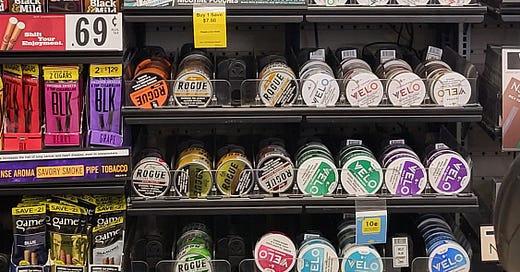Here's a report of popular Nicotine pouches generated by Gemini AI, refining the safety ranking based on available ingredient information, still focusing on the least amount of distinct additives and chemicals (excluding nicotine and water).
Based on the general understanding of these products, and ignoring the nicotine content itself:
Nicotine pouches (Zyn, Velo, On!, Rogue, ALP) are generally considered to have the least amount of dangerous chemicals. These products are tobacco-free, meaning they do not contain tobacco leaf. Instead, they contain nicotine (either tobacco-derived or synthetic), plant fibers, fillers, pH adjusters, sweeteners, and flavorings. The absence of tobacco significantly reduces exposure to the many carcinogens and other harmful chemicals found in tobacco leaf.
Traditional smokeless tobacco products (Skoal, Grizzly, Copenhagen) contain actual tobacco leaf. Tobacco contains numerous harmful chemicals, including tobacco-specific nitrosamines (TSNAs), which are potent carcinogens, as well as other heavy metals and toxic substances. Even though they are "smokeless," they still expose users to these dangerous compounds.
Black & Mild cigars contain pipe tobacco. While cigars are not inhaled in the same way cigarettes are, they still involve the combustion of tobacco, which releases thousands of chemicals, including carcinogens and toxins, into the air and into the user's mouth and throat.
Therefore, among the products pictured, the nicotine pouches (Zyn, Velo, On!, Rogue, ALP) would be considered to have the least amount of dangerous chemicals, excluding the nicotine itself, because they do not contain tobacco leaf.
Ranking Nicotine Pouches by Least Distinct Additives/Chemicals (Approximate)
While all nicotine pouches aim to be tobacco-free and have a relatively simpler ingredient list compared to tobacco products, ranking them precisely by the "least amount of additives and chemicals" in a definitive way is challenging for a few reasons:
Proprietary Blends: Manufacturers don't always disclose the exact proportions or all minor components of their "food-grade flavorings" or "plant-based fibers."
"Additives and Chemicals" is Broad: All of these products contain chemicals (nicotine, pH adjusters, sweeteners, etc.). The question is about dangerous chemicals. Since they are tobacco-free, they generally avoid the known carcinogens found in tobacco leaf combustion or fermentation.
Minor Ingredient Variations: The core ingredients (nicotine, cellulose fillers, water, pH adjusters, sweeteners, flavorings) are largely consistent across brands. The specific type of sweetener (sucralose vs. acesulfame K vs. maltitol) or the specific source of cellulose (wood pulp vs. plant cell walls) can vary, but these are generally considered food-grade and safe in the quantities used.
However, based on publicly available ingredient lists and a focus on minimizing different types of compounds, here's a general, highly nuanced and approximate ranking from potentially "fewer" to "more" distinct additives:
1. Rogue Nicotine Pouches
Often highlight a comparatively shorter ingredient list: "nicotine polacrilex, Acesulfame K, and inactive food-grade ingredients that add texture and flavor." This implies a simpler overall formulation.
They use nicotine polacrilex.
2. ALP Nicotine Pouches
ALP's listed ingredients include: Microcrystalline cellulose, Xylitol, Water, Propylene glycol, Flavorings, Nicotine (tobacco-derived or synthetic), Tartaric acid, Sodium chloride, Sodium carbonate, Sodium bicarbonate, Sucralose, Hydroxypropyl cellulose, Gum arabic.
ALP's list is quite comprehensive, but it still fits within the general profile of nicotine pouches. The inclusion of propylene glycol is noted, which is also a common food additive.
3. Zyn Nicotine Pouches
Zyn generally lists: Nicotine salt (nicotine bitartrate dihydrate), fillers (microcrystalline cellulose, maltitol, gum arabic), stabilizers (hydroxypropyl cellulose), pH balancers (sodium carbonate, sodium bicarbonate), sweeteners (acesulfame potassium, sucralose), and flavorings.
The use of both acesulfame potassium and sucralose for sweetening, and multiple types of fillers/stabilizers, might suggest a slightly broader range of distinct chemical compounds compared to a very minimalist approach.
4. On! Nicotine Pouches
On! generally lists: Nicotine bitartrate dihydrate (nicotine source), maltitol and cellulose powder (binders), sodium carbonate (pH adjuster), and acesulfame K (sweetener), along with flavorings.
Their list appears quite similar to Zyn in terms of core components, often noted for its dry format which can impact the release.
5. VELO Nicotine Pouches
VELO has different formulations depending on whether it's "VELO" or "VELO PLUS."
VELO (Cans): Nicotine derived from tobacco, maltitol, modified cellulose, sodium carbonates, acesulfame K, artificial flavor.
VELO (Tins): Nicotine derived from tobacco, microcrystalline cellulose, water, salt, sucralose, citric acid, artificial flavor.
VELO PLUS: Non-tobacco derived synthetic nicotine, microcrystalline cellulose, sodium carbonates, sucralose, salt, water, artificial flavor.
The fact that VELO has different ingredient lists for different product lines, and some utilize "modified cellulose" or "citric acid" in addition to common ingredients, slightly complicates a simple "least chemicals" comparison. The "PLUS" line uses synthetic nicotine, which avoids tobacco-derived nicotine, but still contains other additives.
Important Caveats:
"Food-Grade" Standards: All major brands use "food-grade" or "pharmaceutical-grade" ingredients. This means the individual chemicals are generally recognized as safe for consumption in the amounts used.
Flavorings: "Flavorings" are often complex mixtures of many individual chemical compounds, and manufacturers are not required to list every single one. A brand might claim a shorter list but have more complex flavoring agents.
This ranking is not a health endorsement. While nicotine pouches are free of tobacco leaf and its associated harmful chemicals, they still deliver addictive nicotine.




